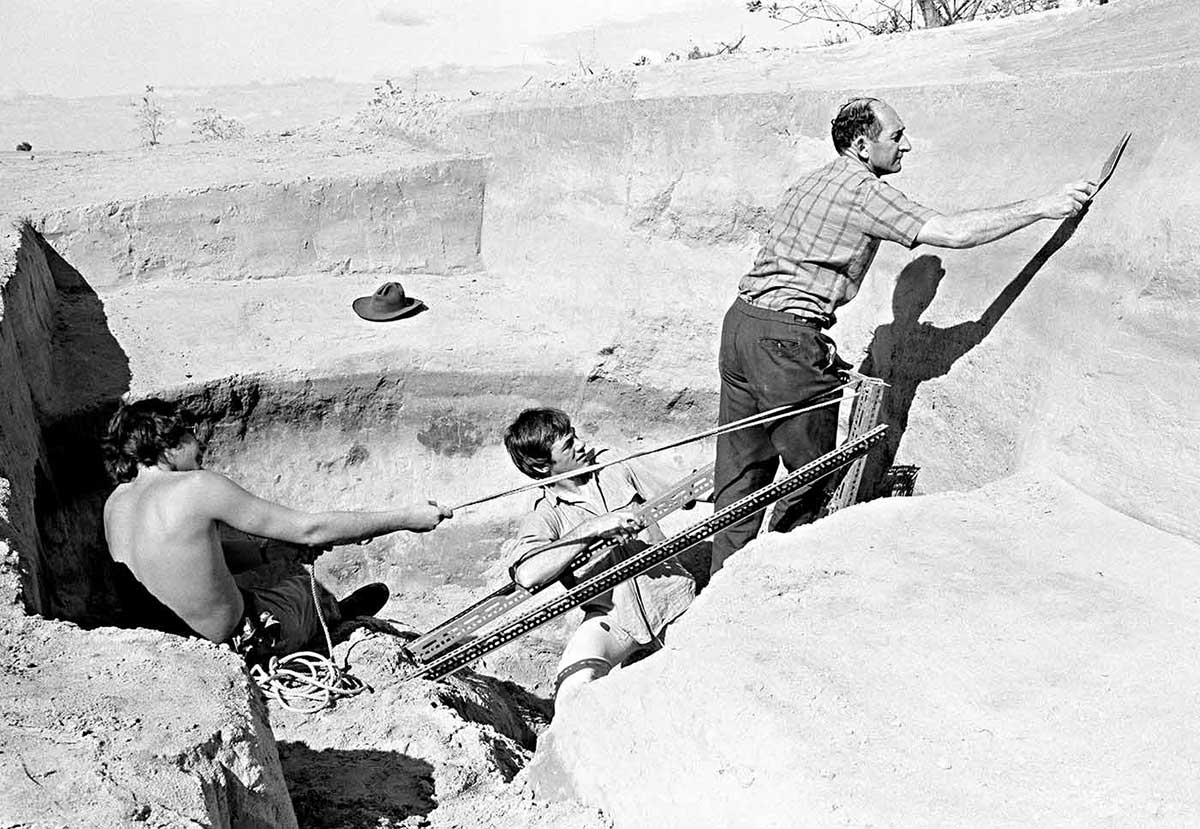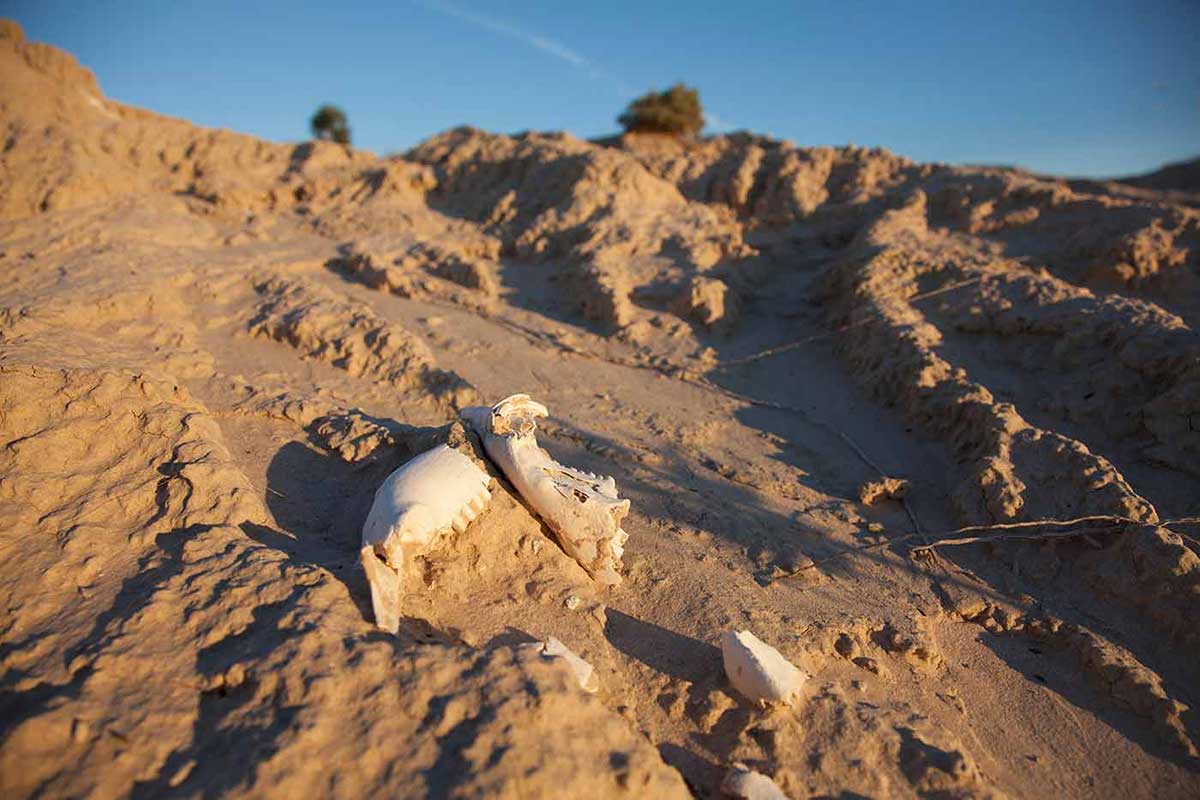In 1968 geologist Jim Bowler discovered human bones around the now dry Lake Mungo in south-western New South Wales. Bowler and his colleagues named her Mungo Lady and discovered that she had been ritually buried.
We now know that the remains of Mungo Lady are 40,000 to 42,000 years old, making them the oldest human remains found anywhere in Australia.
Mungo Lady is also one of the earliest anatomically modern human remains discovered anywhere in the world.
Ann McGrath, Director of the Australian Centre for Indigenous History, Australian National University:
For them [Indigenous people], Mungo Lady had important messages for Australians of all backgrounds – not an object for science, but an important actor in her own right, and one who surfaced for a reason.
Western perspective: land
About 32 million years ago the sea flooded the Murray Basin in which the Willandra Lakes are located. Between three and six million years ago, as sea levels dropped, the coast of southern Australia began a slow retreat towards its current location.
By 150,000 years ago the Willandra Lakes formed as low-lying basins filled with water from the mountains to the east. The levels of the lakes fluctuated over the next 100,000 years depending on the warming or cooling of the climate.
About 40,000 years ago the climate became consistently drier and the world plunged into a cold, glacial phase from 22,000 years ago.
By 10,000 years ago the last Ice Age was over and a relatively stable, semi-arid climate settled over the area.
Western perspective: people
Humans arrived at the lake about 40,000 years ago, probably by following a river from the coast.
They would have found an area full of life. People could have waded and hunted for fish, or dived for yabbies and shellfish. The margins of the lake were well vegetated with reed beds and eucalyptus trees and would have attracted a variety of waterbirds, frogs, mammals and reptiles.
We know from middens (sites holding food waste from that time) that the people who lived at the lake ate freshwater mussels, fish, crayfish, birds’ eggs, mammals and small birds. They built fires to cook their meals, made tools from stone, and used ochre to paint their bodies.
Today, the Paakantji, Mutthi Mutthi and Ngyimpaa people of the region continue to have close connections to the Willandra Lakes.
The Willandra Lakes, including Lake Mungo, are included on the World Heritage list in recognition of their cultural and natural significance.
Secrets of Lake Mungo
Discover what makes Lake Mungo one of Australia's most significant sites.
National Museum of Australia and Ryebuck Media
Oldest humans in Australia
In 1968 geologist Jim Bowler discovered bones emerging from the Lake Mungo lunette (eroded dunes that display major sedimentary layers).
The next year he returned with archaeologists John Mulvaney and Rhys Jones, and with assistance from colleagues at the Australian National University they determined the bones were of a female human.
Moreover, they discovered that Mungo Lady, as she was named, had been ritually buried. First she had been cremated, then her bones were crushed, burned again and buried in the lunette.
Mungo Man
Five years later Jim Bowler found more bones, these turned out to be the skeleton of a male. Analysis has shown that Mungo Man was around 50 years old – a good age for a hunter-gatherer. Like Mungo Lady, he had been ritually buried by being placed on his back with his hands crossed in his lap and his body sprinkled with red ochre.
These two discoveries are the oldest human remains found anywhere in Australia, and some of the earliest anatomically modern human remains discovered anywhere in the world.
The ritual practices identified, namely the cremation of Mungo Lady and the ceremonial burial of Mungo Man, also provide some of the earliest evidence for these cultural practices.
Over the decades, with the development of increasingly accurate archaeological dating techniques, scientists have dated the remains to between 40,000 and 42,000 years ago.
In 2003 nearly 460 ancient footprints were discovered in the clay pan around the lake area – the largest collection of its kind in the world. Dated to 20,000 years ago, these fossilised footprints are also some of the oldest in existence.
Mungo Lady and Mungo Man return home
For the Paakantji, Mutthi Mutthi and Ngyimpaa people, the human remains and other evidence of their ancestors are an important part of their communal history and for them it is crucial that these remains be returned to their country. The remains of Mungo Lady were returned to Lake Mungo in 1992, while Mungo Man’s remains were repatriated in 2017.
In our collection
Explore Defining Moments
You may also like
References
‘Share Mungo Culture’, Mungo National Park
JM Bowler et al, ‘New ages for human occupation and climatic change at Lake Mungo, Australia’, Nature, 2003.
Peter Hiscock, Archaeology of Ancient Australia, Routledge, London, 2008.
Helen Lawrence (ed), Mungo Over Millenia, The Willandra Landscape and its People, Maygog Publishing, Rosny Park, Tasmania, 2006.


